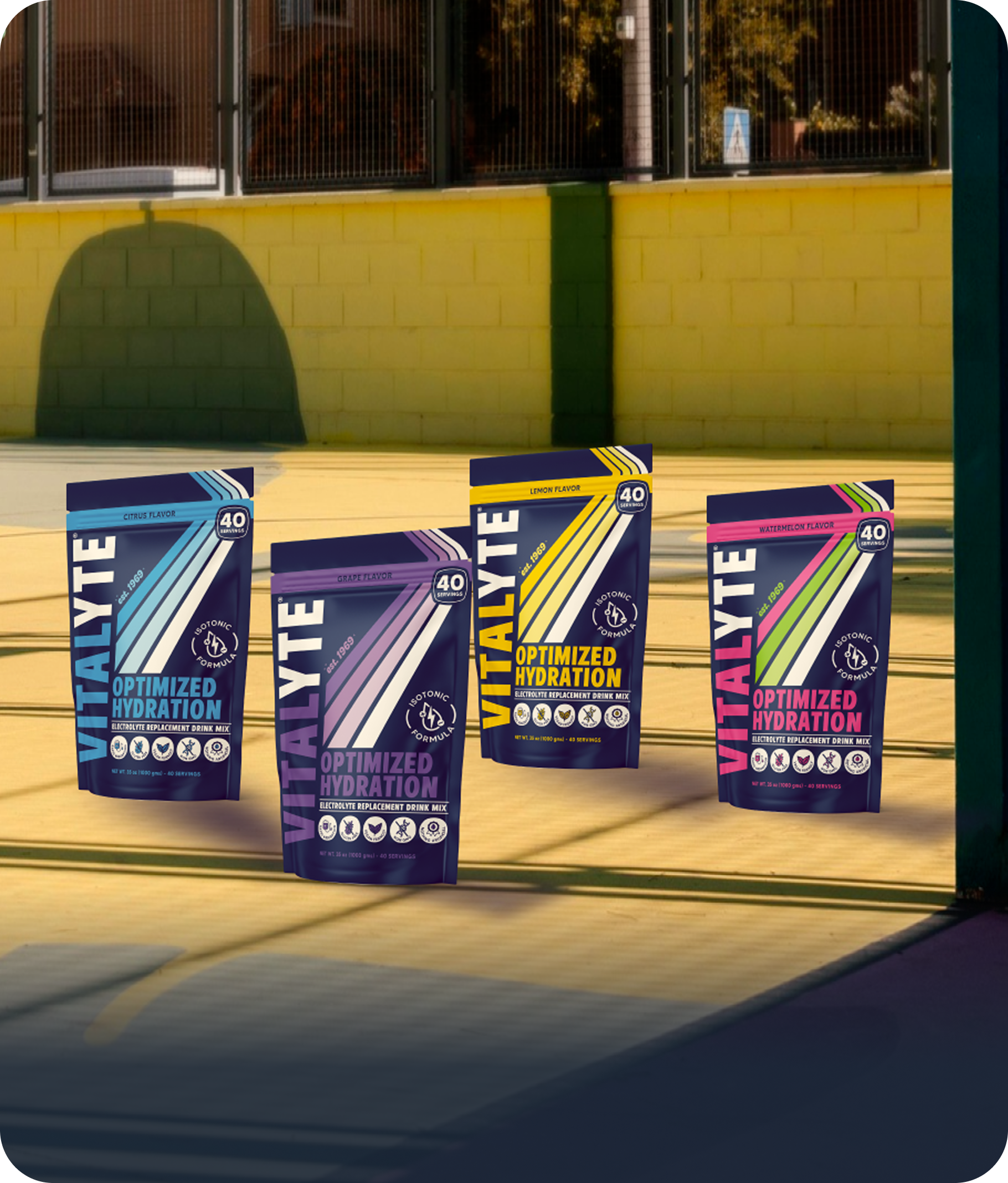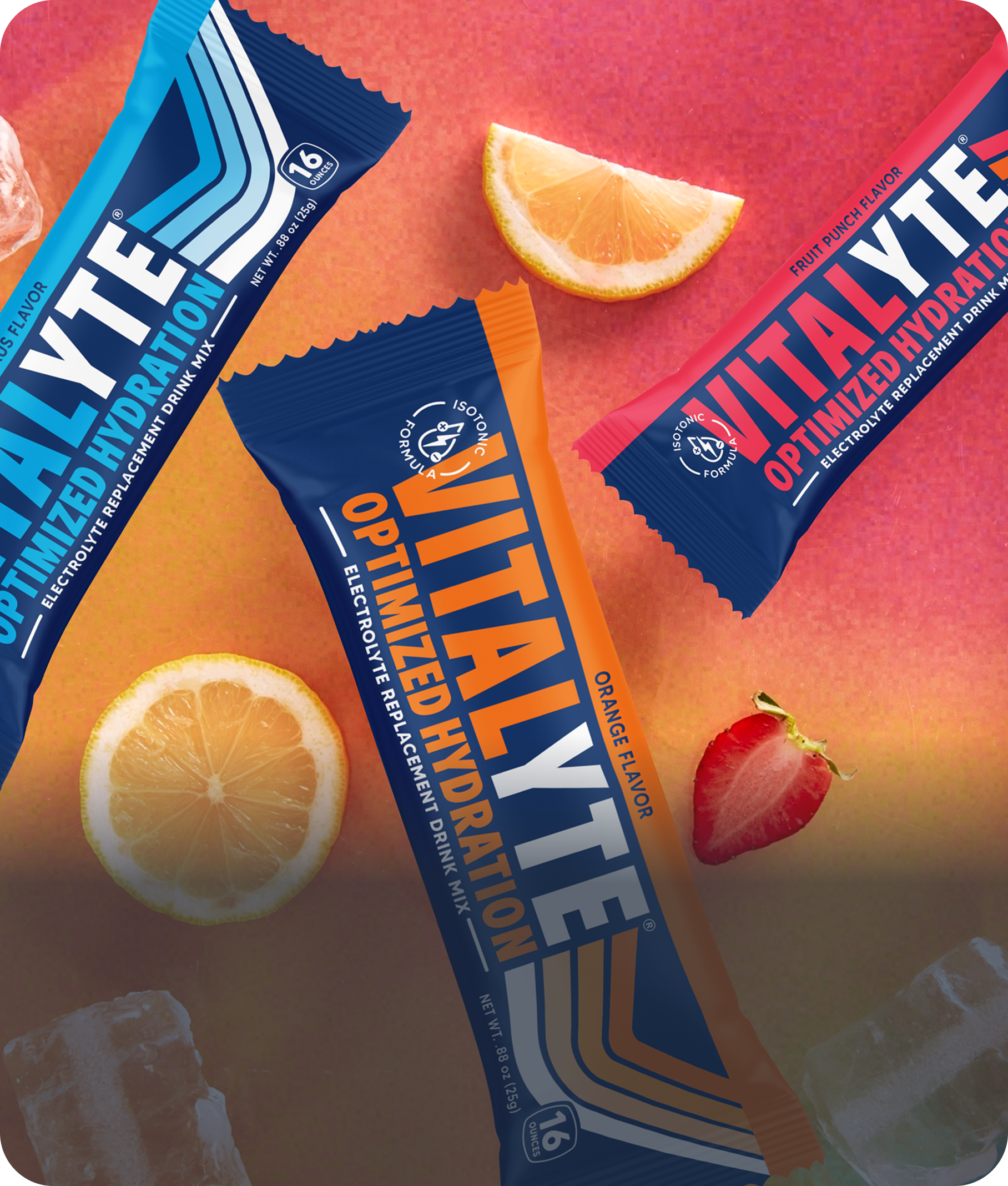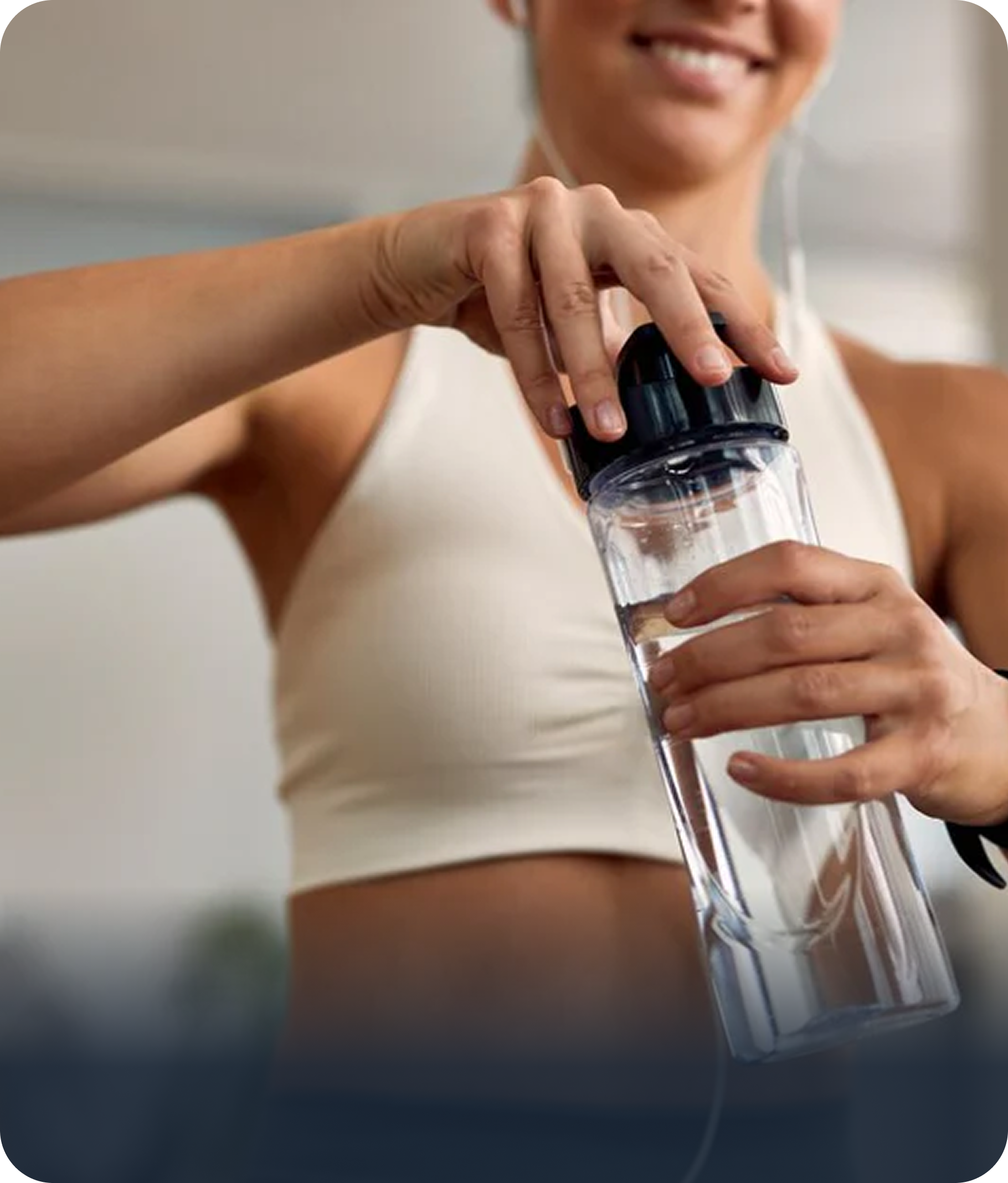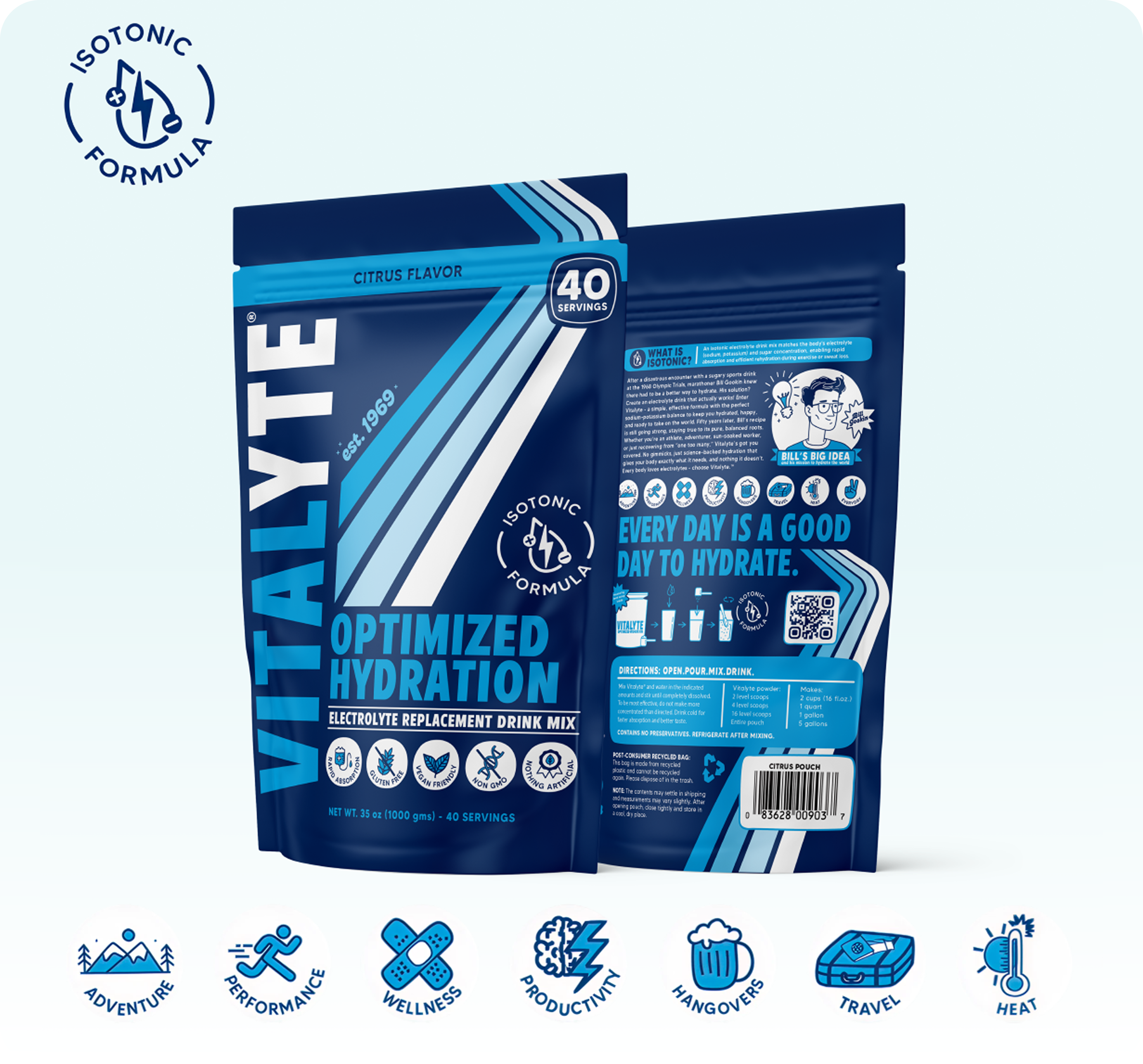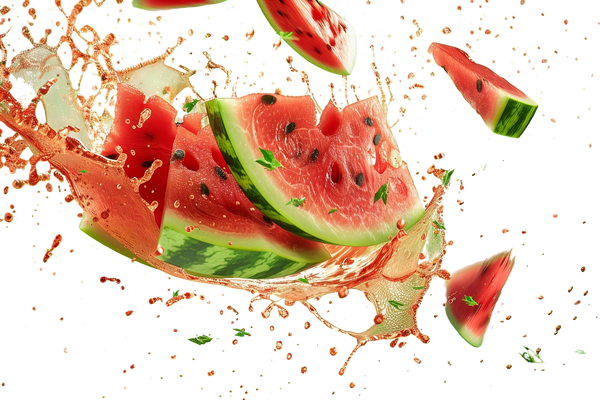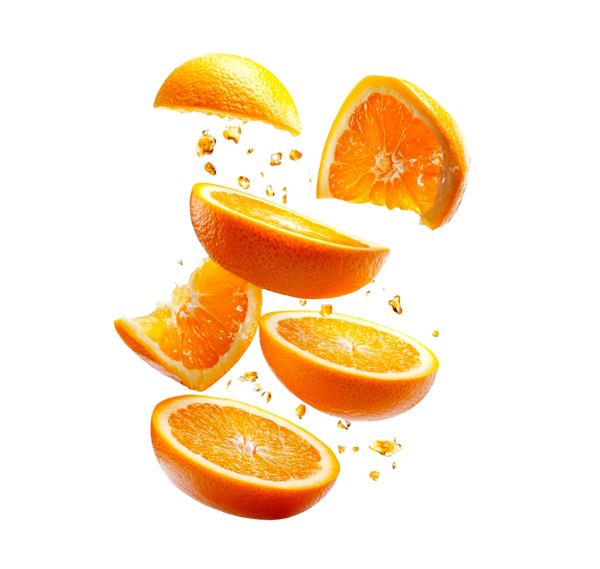The Complete Guide to Electrolyte Powder: What 50 Years of Real-World Testing Taught Us
Share

Last Updated: October 2025
When marathon runner and biochemist Bill Gookin collapsed at the 1968 Olympic Trials after drinking a sugary sports drink, he knew there had to be a better way. That moment sparked a 25-year journey of testing and refinement that would create one of the first science-backed electrolyte powders—a formula that's now been trusted by athletes, workers, and everyday people for over 50 years.
This isn't a story about lab studies or marketing hype. It's about real-world testing, athlete feedback, and a biochemist's obsession with creating a hydration solution that actually works.
In this guide, you'll discover:
-
What electrolyte powder actually is and how it works in your body
-
The critical differences between formulations (and why they matter)
-
How to choose the right product for your specific needs
-
When electrolyte powder helps—and when plain water is enough
-
What five decades of athlete testing revealed about optimal hydration
Whether you're an endurance athlete, work outdoors in the heat, or simply want to optimize your daily hydration, understanding electrolyte powder can make a significant difference in how you feel and perform.
Looking for a science-backed formula refined over 50 years? Explore Vitalyte's electrolyte powder collection."
What Is Electrolyte Powder?
Electrolyte powder is a concentrated blend of essential minerals, primarily sodium, potassium, magnesium, and calcium, that dissolves in water to create a hydration solution. When dissolved in water, these minerals carry electrical charges that are essential for multiple bodily functions, including:
-
Fluid balance: Regulating how much water stays in your cells versus your bloodstream
-
Muscle function: Triggering contractions and preventing cramps
-
Nerve signaling: Transmitting messages between your brain and body
-
pH balance: Maintaining proper acidity levels in your blood and tissues
When you sweat, breathe, or even just exist, you lose both water and electrolytes. Plain water replaces the H2O, but not the minerals. That's where electrolyte powder comes in—it replenishes both simultaneously.
Why Powder Instead of Sports Drinks?
Traditional sports drinks have three major drawbacks that Bill Gookin discovered through decades of testing:
-
Too much sugar: High sugar concentrations (6-8%) actually slow absorption and can pull water from your body into your digestive system—exactly the opposite of what you need when dehydrated.
-
Poor electrolyte ratios: Many contain 5 times more sodium than potassium, which forces your body to deplete its own potassium reserves to maintain balance. This can trigger the whole-body cramping that affected Olympic swimmer Amy Van Dyken at the 1996 Atlanta Olympics.
-
Artificial additives: Colors, flavors, and preservatives that provide zero hydration benefit and may cause stomach discomfort during activity.
Electrolyte powder gives you control. You decide the concentration, avoid unnecessary additives, and get a formula optimized for absorption rather than shelf appeal.
 The Science of Isotonic Formulas: What 25 Years of Testing Revealed
The Science of Isotonic Formulas: What 25 Years of Testing Revealed
After the 1968 Olympic Trials disaster, Bill Gookin spent 25 years testing different formulations on himself and other athletes, experimenting with different ratios, concentrations, and ingredients. The result? A formula so optimized that he realized further refinement was physiologically impossible. He'd achieved the maximum speed and effectiveness the human body could absorb.
The Isotonic Advantage
An isotonic formula matches your body's natural concentration of electrolytes and sugars (approximately 280-300 mOsm/L)—the optimal range recommended by sports medicine researchers for fluid replacement during exercise. This creates three critical benefits:
1. Rapid Absorption When the concentration in your stomach matches your bloodstream, fluids pass through the intestinal wall almost immediately—like IV-level hydration that you can drink. No waiting, no stomach sloshing.
2. No Water Displacement Hypertonic solutions (too concentrated) actually pull water from your bloodstream into your digestive system to dilute themselves. This is what happened to Amy Van Dyken—concentrated sports drinks caused chain-reaction cramping across her entire body.
3. Gentle on the Stomach Lower sugar content (around 4-5% carbohydrates) means faster gastric emptying and less nausea during intense activity. Athletes who cramp or feel sick from traditional sports drinks often have no issues with properly formulated isotonic solutions.
The Sodium-Potassium Balance That Matters
Here's what Bill Gookin discovered that changed everything: Too much sodium causes you to lose your own potassium reserves.
When sports drinks contain 5:1 or higher sodium-to-potassium ratios, your body has to work overtime to maintain cellular balance. Sodium pulls water from circulation into tissues—reducing blood volume and forcing your kidneys to dump potassium to keep up with sodium losses.
The result? Dehydration despite drinking fluids, increased heart stress, and eventual cramping.
Vitalyte's ratio (135mg sodium to 193mg potassium per 16oz serving) maintains approximately a 1:1.4 balance—much closer to what your body actually loses in sweat and what it needs for optimal cellular function.
How to Choose Quality Electrolyte Powder: A 50-Year Perspective
After supplying Search & Rescue teams, medical relief operations in Rwanda and Bangladesh, and generations of endurance athletes, here's what real-world testing revealed about choosing electrolyte powder:
1. Check the Sodium Content
The Sweet Spot: 100-150mg per serving
This provides enough sodium for the SGLT1 sodium-glucose co-transport mechanism (which accelerates water absorption) without overwhelming your system.
Red Flags:
-
Under 50mg: Won't activate optimal absorption
-
Over 300mg: Can deplete potassium and pull water from circulation
-
Over 1000mg: Only appropriate for specific medical conditions or extreme situations
2. Look for Balanced Potassium
Target: Equal to or greater than sodium
Potassium helps sodium do its job while preventing mineral imbalances. The ideal ratio is roughly 1:1 to 1:1.5 (sodium:potassium).
Many commercial sports drinks have inverted ratios (5:1 or worse), which can cause more problems than they solve.
3. Sugar Content Matters—But Not How You Think
The Goldilocks Zone: 4-6% carbohydrate concentration
Too little sugar (<2%) and you don't get the sodium-glucose co-transport boost. Too much (>8%) and you slow gastric emptying and risk pulling water into your digestive tract.
Bill Gookin discovered through testing that 4.65% was the optimal concentration—enough to enhance absorption without causing stomach issues or delayed hydration.
4. Avoid Artificial Everything
After 50+ years of athlete feedback, one pattern is crystal clear: Natural flavors, no artificial colors, no artificial sweeteners = better tolerance during activity.
Artificial additives may be fine when you're sitting at a desk, but during intense exercise or heat stress, they frequently cause:
-
Stomach cramping
-
Nausea
-
Altered taste perception (making you less likely to drink enough)
5. Consider the Form Factor
Powder vs. Tablets vs. Ready-to-Drink:
-
Powder: Most economical ($0.50-0.75 per serving), customizable concentration, longest shelf life
-
Tablets: Convenient, portable, but typically underdosed and more expensive per serving
-
Ready-to-Drink: Maximum convenience, but often use preservatives and cost 3-5x more
Electrolyte Powder vs. Sports Drinks: An Honest Comparison
Let's be transparent about when each makes sense. This comparison is based on independent testing and 50+ years of athlete feedback:

Electrolyte Powder (Isotonic Formula)
Pros:
-
Fast absorption (isotonic = IV-like speed)
-
Natural ingredients, gentle on stomach
-
Balanced electrolyte ratios prevent depletion
-
Cost-effective ($0.61/serving vs $2-3 for bottled drinks)
-
No artificial sweeteners or colors
-
Customizable concentration
Cons:
-
Requires mixing (not grab-and-go)
-
Less sweet taste may take adjustment
-
Must carry powder container
Best For:
-
Endurance athletes (marathons, cycling, triathlons)
-
Workers in hot conditions
-
Daily hydration optimization
-
Anyone prone to cramping or stomach issues with traditional sports drinks
Traditional Sports Drinks (Gatorade, Powerade)
Pros:
-
Widely available
-
Ready to drink
-
Sweet taste familiar to most
-
Some energy from higher sugar content
Cons:
-
High sugar concentration slows absorption (6-8% vs optimal 4-5%)
-
Poor sodium-potassium ratios (often 5:1 or worse)
-
Artificial colors and flavors
-
3-5x more expensive per serving
-
Can cause stomach discomfort during activity
Best For:
-
Casual activity under 60 minutes
-
When convenience trumps everything
-
When you need quick energy more than optimal hydration
High-Sodium Formulas (LMNT, etc.)
Pros:
-
Supports ketogenic/low-carb diets
-
Zero sugar
-
Effective for people adapted to high sodium intake
Cons:
-
Very high sodium (1000mg) can deplete potassium
-
Salty taste unpleasant for many
-
Not isotonic—slower absorption
-
May cause water retention
-
$2+ per serving
Best For:
-
Keto/carnivore diet followers
-
People with diagnosed sodium deficiency
-
Those already adapted to high salt intake
DIY Electrolyte Solutions
Pros:
-
Cheapest option ($0.10-0.20 per serving)
-
Total ingredient control
Cons:
-
Difficult to get ratios right
-
Time-consuming to mix
-
Usually tastes terrible
-
No convenience for on-the-go use
Best For:
-
Budget-conscious users willing to experiment
-
Those with very specific dietary restrictions
Bottom Line: For most active people seeking optimal hydration, an isotonic electrolyte powder with balanced ratios offers the best combination of effectiveness, cost, and stomach tolerance. The 50+ years of athlete feedback on formulas like Vitalyte consistently shows better performance and fewer issues compared to alternatives.
Shop isotonic electrolyte powder with balanced sodium-potassium ratios.
When to Use Electrolyte Powder (And When Plain Water Is Enough)
This is where real-world experience matters. Here's what five decades of testing across different activities, climates, and users revealed:
You NEED Electrolyte Powder When:
Exercise Over 60 Minutes Once you're sweating continuously for an hour+, you're losing significant electrolytes. This is when cramping, fatigue, and mental fog typically start without replacement.
Hot Weather or High Humidity Temperature above 80°F or humidity above 60%? Your sweat rate increases dramatically. Search & Rescue teams using Vitalyte report it's essential for preventing heat exhaustion during summer operations.
Altitude Above 8,000 Feet Increased respiration at altitude means more water and electrolyte loss through breathing. Mountain athletes and climbers rely on electrolyte powder for summit attempts.
Illness Recovery Fever, vomiting, or diarrhea can deplete electrolytes rapidly. Medical relief teams in Rwanda and Bangladesh used Gookinaid (now Vitalyte) to save lives during cholera and dysentery outbreaks—situations where IV fluids weren't available.
Hangover Prevention/Recovery Alcohol is an anti-antidiuretic (suppresses the hormone that retains water) and pulls fluid directly from tissues. Electrolyte powder helps rehydrate faster and replenish depleted minerals. As Boston sportscasters famously said during the 1978 marathon: "Gookinaid is the best thing in the world for hangovers!"
Multiple Workouts Per Day If you're training twice daily, you need active electrolyte replenishment between sessions—not just water.
Low-Carb or Ketogenic Diets These diets cause increased water and electrolyte loss through kidneys. Supplementation prevents "keto flu" symptoms.
Plain Water Is Fine When:
-
Exercise under 45-60 minutes at moderate intensity
-
Cool weather (under 70°F) with low humidity
-
Sedentary days with regular meals (food provides electrolytes)
-
You've just started noticing thirst (early stage)
The Rule of Thumb: If you'll sweat for more than 45 minutes or lose fluids through any mechanism (altitude, heat, illness), electrolyte powder significantly improves outcomes.
How to Use Electrolyte Powder for Optimal Results
After 50+ years of athlete feedback, certain patterns consistently produce the best results:
Dosage and Concentration
Standard Serving: 2 scoops (25g) per 16oz water
This creates an isotonic solution (~280-300 mOsm/L) that matches your body's concentration.
Critical: Don't make it stronger than directed. More concentrated doesn't mean better—it actually slows absorption and can cause the same water-displacement problems as sugary sports drinks.
Timing Strategies
Before Activity (30 minutes prior) Pre-hydrate with 12-16oz of electrolyte solution. This ensures you start with optimal fluid balance and gives your body time to absorb what it needs and eliminate excess.
During Activity Sip 6-8oz every 15-20 minutes. Small, frequent amounts prevent stomach sloshing and maintain steady hydration. Ultra-runners and cyclists use this strategy to prevent cramping during events lasting 4+ hours.
After Activity Drink 16-24oz within 30 minutes of finishing. This accelerates recovery, reduces next-day muscle soreness, and prevents delayed cramping. Tennis players report this prevents the "tight muscle" feeling the day after matches.
Daily Use One serving in the morning jump-starts hydration after overnight fluid loss. Office workers report better focus and less afternoon fatigue when starting the day with electrolytes rather than just coffee.
Temperature Matters
Drink it cold. Cold fluids empty from the stomach faster and are more palatable during activity. Room-temperature electrolyte drinks get left in bottles because they're unappealing—and fluid you don't drink doesn't help.
Special Situations
Night Cramps If you wake with leg cramps, you're dehydrated with low electrolytes (especially calcium). Drink 12-16oz of electrolyte solution before bed. Unlike plain water, an isotonic formula won't make you wake up to use the bathroom as frequently.
Air Travel Airplane cabin humidity is around 10-20% (desert-level). Drink 8oz per hour of flight to counteract the drying effects. Frequent travelers swear by this for preventing jet lag and arrival fatigue.
Construction/Outdoor Work Workers in the heat need continuous replacement. Foremen report fewer heat-related incidents when crews drink electrolyte solutions throughout shifts rather than waiting for breaks.
Common Electrolyte Powder Mistakes (And How to Avoid Them)
Five decades of experience reveals these patterns:
Mistake #1: Waiting Until You're Thirsty
The Problem: Thirst is a late-stage dehydration signal. Mental performance declines first—you'll make poor decisions, lose focus, and react slower before you ever feel thirsty.
The Fix: Hydrate on a schedule during activity. Set a timer for every 15-20 minutes if needed.
Mistake #2: Making It Too Concentrated
The Problem: "More powder = better hydration" is false. Hypertonic solutions pull water from your bloodstream into your digestive tract—causing dehydration despite drinking.
The Fix: Follow package directions exactly. Two scoops per 16oz means two scoops per 16oz, not per 8oz.
Mistake #3: Mixing with Hot Water
The Problem: Hot fluids empty from the stomach slowly and are unappealing during activity.
The Fix: Always use cold water. Better absorption, better taste, more likely to drink enough.
Mistake #4: Using Only During Intense Exercise
The Problem: Daily dehydration from regular activities (desk work, mild heat, morning coffee) accumulates over time, affecting energy, cognition, and recovery.
The Fix: One serving in the morning or mid-afternoon can significantly improve daily function—not just workout performance.
Mistake #5: Ignoring Quality Differences
The Problem: Assuming all electrolyte powders are the same. They're not. Ratios, concentrations, and ingredient quality vary dramatically.
The Fix: Look for balanced sodium-potassium ratios (close to 1:1), isotonic concentrations (4-6% carbs), and natural ingredients. Cheaper isn't better if it doesn't work or causes stomach issues.
Who Benefits Most from Electrolyte Powder?
Real-world testing over 50+ years reveals these groups see the most dramatic improvements:
Endurance Athletes
Marathoners, Ultra-Runners, Cyclists, Triathletes
When exercise extends beyond 90 minutes, electrolyte depletion becomes the limiting factor—not fitness. The athletes who've used isotonic formulas for decades report:
-
Fewer cramps, especially in late race stages
-
Better mental clarity for pacing decisions
-
Faster recovery between training sessions
-
Ability to perform well in heat
A marathon runner using proper electrolyte strategy drinks about 48-64oz during a 4-hour race—that's 3-4 servings providing 400-540mg sodium and 580-770mg potassium. Compare that to plain water (0mg of both) and you see why serious athletes won't race without it.
Outdoor Workers
Construction, Landscaping, Firefighters, Military
Heat-related incidents drop dramatically when crews have access to electrolyte solutions. These aren't "athletes" in the traditional sense, but they're performing physical labor in challenging conditions—sometimes for 8-12 hour shifts.
The feedback is consistent: fewer headaches, less fatigue, maintained productivity through hot afternoons, and significantly reduced risk of heat exhaustion.
Office Workers and Travelers
This surprises people, but desk workers and frequent flyers see substantial benefits:
Office Workers: Sitting for long periods can cause "localized dehydration"—fluids pool in legs and feet. Brain fog and afternoon energy crashes are often dehydration symptoms. One serving mid-morning or early afternoon improves focus and energy.
Travelers: Airplane cabins, hotel air conditioning, and disrupted routines all contribute to dehydration. Starting the day with electrolytes helps prevent the fatigue and poor sleep that often accompany business travel.
People on Specific Diets
Ketogenic, Low-Carb, Carnivore, Intermittent Fasting
These dietary approaches cause increased electrolyte loss through kidneys. "Keto flu" symptoms (headache, fatigue, irritability, muscle cramps) are actually electrolyte deficiency symptoms. Daily supplementation often eliminates these issues entirely.
Older Adults
As we age, thirst signals become less reliable and kidney function changes. Many older adults are chronically under-hydrated without realizing it. This contributes to:
-
Confusion and cognitive decline
-
Constipation
-
Urinary tract infections
-
Falls (from dizziness/weakness)
Light, daily electrolyte use—especially in warm months—can significantly improve quality of life.
Quality Matters: What to Look for in Brands
After five decades of formulation refinement and market observation, here's what separates effective products from marketing gimmicks:
Third-Party Testing and Transparency
Look for brands that:
-
Publish complete ingredient lists with amounts (not just "proprietary blends")
-
Have been independently assessed for formulation effectiveness
-
Are transparent about manufacturing processes
-
Don't make exaggerated claims (like "3x faster hydration than water"—that's just how electrolytes work, not a special feature)
Heritage and Real-World Use
Products refined through actual athlete feedback over years or decades tend to outperform ones developed primarily for marketing appeal. Vitalyte's formula, for example, has been tested and refined since 1969 through real-world use by Search & Rescue teams, ultra-endurance athletes, and everyday users. Consider:
-
How long has the formula existed?
-
Who actually uses it? (Real athletes/workers vs. influencer endorsements)
-
Does it have testimonials about performance in extreme situations?
Search & Rescue teams, medical relief operations, and ultra-endurance events are proving grounds. If a product works there, it works.
No Artificial Anything
This isn't a "clean label" marketing thing—it's practical. Artificial sweeteners, colors, and flavors frequently cause:
-
Stomach distress during activity
-
Altered taste perception that reduces consumption
-
Unnecessary ingredient exposure with no benefit
Natural doesn't mean "better" in all contexts, but for products you'll consume during physical stress, simpler is reliably better.
Appropriate Sodium Levels
Be skeptical of products with:
-
Under 50mg sodium per serving (won't activate optimal absorption)
-
Over 300mg for general use (can deplete potassium, cause water retention)
-
Marketing that emphasizes "more is better" for electrolytes
The optimal amount was discovered through testing, not marketing preferences.
Cost Per Serving
Quality electrolyte powder should cost $0.50-0.80 per serving. Much cheaper often means poor formulation or missing key ingredients. Much more expensive is usually paying for packaging or marketing rather than better ingredients.
The Bottom Line: 50 Years of Testing in Perspective
When Bill Gookin started testing formulations in 1968, electrolyte replacement was poorly understood. Most sports drinks were designed to taste good on store shelves, not to actually optimize hydration.
After 25 years of refining ratios, testing concentrations, and gathering athlete feedback, he discovered something profound: There's an optimal formula that can't be improved upon—isotonic concentration, balanced electrolytes, natural ingredients, and nothing unnecessary.
That formula, originally called Gookinaid and renamed Vitalyte in 2007-2008, has now been used for over 50 years by:
-
Marathon runners seeking personal records
-
Ultra-endurance athletes pushing 100+ mile efforts
-
Search & Rescue teams preventing heat casualties
-
Medical relief operations saving lives during cholera outbreaks
-
Construction workers maintaining productivity in extreme heat
-
Everyday people just wanting to feel their best
The lessons from five decades are clear:
Electrolyte powder works—when it's formulated correctly. Balanced ratios matter more than high doses. Isotonic concentration beats hypertonic every time. Natural ingredients cause fewer problems than artificial ones. And real-world testing with actual users reveals what laboratory studies and marketing departments miss.
If you're serious about hydration—whether for performance, work, or daily well-being—choose a formula that's been refined through decades of use, not one designed to look good in social media ads.
Your body will know the difference.
Frequently Asked Questions
Q: Can I just eat salty foods instead of using electrolyte powder?
A: Food provides electrolytes, but not in the rapid, balanced way needed during activity or acute dehydration. Salty foods often provide too much sodium relative to potassium, and the digestion process slows absorption significantly. For daily maintenance, food is fine. For active hydration needs, powder is more effective.
Q: Is electrolyte powder safe for daily use?
A: Yes, for most people. One serving daily is well within safe limits and can improve overall hydration status. However, if you have kidney disease, heart conditions, or take medications affecting electrolyte balance, consult your physician first.
Q: What to look for when buying electrolyte powder?
A: Quality electrolyte powder should have balanced sodium to potassium ratios around 1:1, isotonic concentration at 4 to 6% carbohydrates, and 100 to 150mg sodium per serving. Natural ingredients matter because artificial colors and sweeteners cause stomach issues during activity. Check that the electrolyte powder costs between 50 to 80 cents per serving. Cheaper formulas often skip key minerals while expensive options usually charge for packaging rather than better ingredients. Look for electrolyte powder brands with transparent labeling that shows exact mineral amounts instead of hiding behind proprietary blends. The best electrolyte powder formulas are refined through real athlete testing over years, not just designed in marketing departments.
Q: Can kids use electrolyte powder?
A: Yes, though they need less. For children, use half the adult serving in the same amount of water (creating a more dilute solution). This is especially helpful for active kids, youth athletes, or during illness. Consult your pediatrician for children under 2.
Q: Will electrolyte powder break my fast?
A: It depends on your fasting goal. Most electrolyte powders contain 15-25g of carbohydrates (60-100 calories) per serving, which technically breaks a "water fast." However, for electrolyte balance during extended fasts (especially for those on ketogenic diets), the benefits often outweigh strict fasting protocols. Some people use half servings or look for zero-calorie options.
Q: Why do some electrolyte products taste salty?
A: High-sodium formulas (1000mg+) taste salty because they contain large amounts of sodium chloride (salt). Balanced formulas with moderate sodium (100-150mg) and fruit-based flavoring taste refreshing rather than salty. Taste is a good indicator of formulation—if it tastes like seawater, it's probably unbalanced.
Q: How long does mixed electrolyte solution stay good?
A: In the refrigerator, 24-48 hours. At room temperature, drink within 4-6 hours. Bacteria grow in glucose-containing solutions, so don't leave bottles sitting for days. Mix fresh batches as needed.
Ready to experience the difference 50 years of real-world testing makes? Shop Vitalyte Electrolyte Powder
Disclaimer: This article is for informational purposes only and doesn't constitute medical advice. If you have underlying health conditions or take medications affecting electrolyte balance, consult your healthcare provider before using electrolyte supplements.
About the Author
Evan Lucas, COO of Vitalyte
Evan has been with Vitalyte for 27 years, working to carry forward Bill Gookin's legacy of creating honest, effective hydration solutions. He uses Vitalyte daily for general wellness and hydration, and helps guide the company's commitment to real-world testing and straightforward science over marketing hype.
